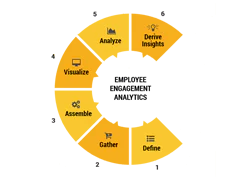
The Gallup report estimates that there is a 20% increase in employee productivity and organizational profitability in organizations that provide a well-planned employee engagement. The report also estimates that disengaged employees cost the American economy $350 billion a year. Employee engagement is the soul of HR activities. But, most tools keep it as a good to have feature. Human capital is one of the least measured and analyzed investments. Measuring it against short-term business productivity may severely limit its scope. Hence, having an aptly framed employee engagement program is very essential.
Executives are realizing that they do not have a firm grasp on the characteristics and capabilities of their workforce. This is where employee engagement tools come to the rescue of HR. A successful employee engagement tool not only has the strategies for employee engagement, but also has built in analytics. The crux of employee engagement tools needs to be around analytics, w.r.t. various characteristics. Let us have a look at a few must have features in an end-to-end employee engagement tool.
Collection
Current employee engagement tools have static data collection strategies. But, in an organization, data for employees is scattered across various systems. Performance is tracked by managers in their PM tool, team has different collaboration tools, HR system has some HRIS, whereas, payroll data is with payroll system. On top of this, different departments have different tools. So to get the analytics across departments is again a challenge. System architected to gather data from any such data sources dynamically will make employee engagement analytics tool a robust one. This in turn, will have the perfect desired predictions as all the aspects related to employees across organizations are considered.
Integration
Integration is an integral part of any employee engagement product. But major employee engagement analytics tools either have manual integration or no integrations at all. Manual integration uses import export mechanisms to integrate the data across system. In order to integrate data, format of one system needs to be converted to a format that other systems understand and vice versa. The reason being, every other platform has different format of data. Also extracting the exact required data from all such platforms is another challenge. Thus, having real time data across systems is another aspect that needs to be addressed for competitive advantage. API based integration facilitates this real-time collaboration. This also solves the issue in integrating with various systems without knowing each other’s architecture, extracting the data in required format and making it available for employee engagement analytics tools.
Transformation
In order to gain deeper insights, the extracted data from various sources needs to be transformed. Removing duplicates, data cleansing, anonymization of data is needed for better scalability and focus on the right measurement parameter. There are different ways of transformations. For example, merging is required where one needs to compare the KPI rating across organization, anonymization is required where one needs to relate the text comments in review forms, data scrubbing is required to eliminate confidential information, and so on. With transformation, NLP plays a vital role on processing the texts on reviews, and open text descriptive answer-based surveys. Applying the right technique at the right place in required order is key to get the required result of the analytics performed. When done right, this can deliver a lot of value.
Visualization and correlation
Template based reports are not very useful for meaningful insights. Self-service reporting framework is needed to create custom reports for each organization depending on data, size and other inter-dependencies. There are many hidden sub groups of employees within organizations which may have interesting patterns when visualized. To name a few, these are department-wise, role-wise, and gender-wise among others. Analytics needs to be around such characteristics. Few examples of how such visualization helps in correlating is as follows. Department wise analytics of participation of employee engagement activities will help HR to launch next activity in better way. Another example can be, while doing sentimental analysis of review, one can find the new role is challenging for an employee. Manager could provide the guidelines, and hence next review shows positive feedback in it. Competency models for each job role can be tracked per employee per department.
This completes the cycle and the purpose of having the engagement tool in the system. In order to achieve this the tool must be able to analyze and visualize the factors that correlate with each other. Employee engagement tool is all about integration of various people metrics with business metrics across an organization to deep dive into multiple factors that affect the organization’s human capital and predict the decisions on top of it. The best tool should be able to create the base model from analytics and map the differences to reach the target model.
Times are changing. Engagement initiatives need to be viewed from a continuous process improvement perspective. The ethos and culture of the very origination is based on the idea of engagement and it’s the primary responsibility of HR to be its guardian. Having analytics to give deep insights of such initiatives is the crux of it.





